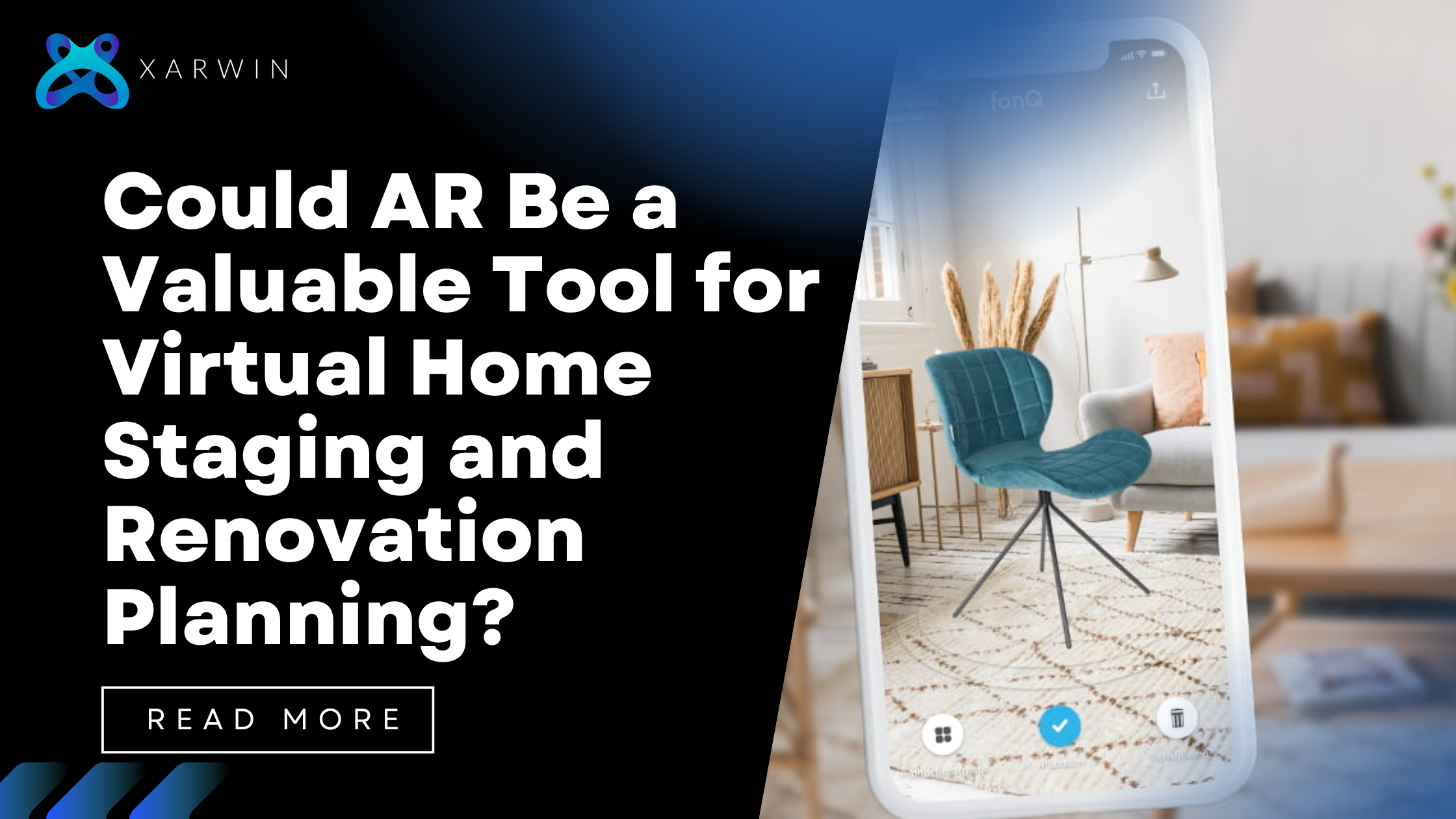Imagine you’re sitting at home, scrolling through countless property listings online, trying to find the perfect home for you and your family. You’re tired of the same old static images and videos that don’t give you a true sense of the property.
But what if there was a way to step into the property, to walk through it like you were really there? That’s where augmented reality comes in.
By offering a realistic and immersive virtual tour experience, augmented reality is revolutionizing the real estate industry, enhancing buyer engagement, and boosting property sales.
In this blog post, we’ll explore the benefits of using augmented reality in real estate, how it can be used to create immersive property tours, and the impact it has on sales.
It’s time to step into the future of real estate with augmented reality.
What is Augmented Reality in Real Estate?
Augmented reality is a technology that overlays virtual elements onto the real world. In real estate, AR technology is used to create an interactive and immersive experience for buyers.
By using an AR-enabled device, such as a smartphone or tablet, buyers can explore properties in a realistic and interactive way.
AR technology is designed to provide a more detailed and interactive experience that goes beyond traditional static images and videos, allowing buyers to explore every corner of the property and interact with virtual elements.
Growing Adoption of AR in Real Estate
The use of augmented reality in real estate is becoming increasingly popular. According to a report by Goldman Sachs, the real estate industry will be one of the top industries to benefit from AR technology.
Realtors are recognizing the potential of AR to create engaging and memorable experiences for buyers, and to showcase properties in a more effective way. AR technology is now being used by real estate agents to provide homebuyers with a more immersive and interactive experience.
Realtors are using AR technology to create virtual tours that allow buyers to explore properties in a more detailed and interactive way.
Benefits of Using AR for Property Marketing and Sales
Augmented reality (AR) is a transformative technology that is changing the way the real estate industry operates. Here are some of the key benefits of using AR in real estate:
Improved Buyer Engagement
- AR technology allows real estate agents to engage buyers through interactive elements and features.
- AR overlays and annotations can highlight property details and showcase unique features, creating emotional connections with properties that are essential in driving buyer interest.
- AR technology can help reduce uncertainty and apprehension in the buying process by allowing buyers to explore properties in detail.
- With AR, buyers can get a more detailed and realistic view of the property on their first visit, reducing the number of visits needed to close a deal.
Building Buyer Confidence
- By giving buyers a more detailed and realistic view of the property, realtors can help them feel more confident in their decision-making process.
- AR technology can help address buyer questions and concerns, ultimately building buyer confidence.
- For example, if a buyer is concerned about the amount of natural light in a property, realtors can use AR to show the buyer exactly how the light enters the space at different times of day.
Quicker Decision-Making Process
- The use of augmented reality in real estate can significantly shorten the sales cycle.
- By creating an engaging and memorable experience, AR technology encourages quicker and more informed purchase decisions.
- With traditional property tours, buyers may need to visit a property multiple times before they feel confident in making an offer. With AR, buyers can get a more detailed and realistic view of the property on their first visit.
Immersive Virtual Property Walkthroughs
- AR technology allows buyers to explore properties in a more immersive and interactive way than traditional static images and videos.
- Buyers can explore every nook and cranny of the property from any angle they choose.
- Buyers can move through rooms, visualize the space with different furniture layouts, and even get a sense of what the view looks like from different windows.
- AR technology offers a realistic and interactive experience that goes beyond traditional static images and videos.
- AR-enabled virtual staging can help buyers visualize how a property could look with different furniture and decor, making it easier for them to imagine themselves living there.
Interactive Property Showcase
Augmented reality platform allows realtors to engage buyers through interactive elements and features. With AR overlays and annotations, realtors can highlight property details and show off unique features.
This level of interactivity helps to create emotional connections with properties, which is essential in driving buyer interest.
For example, if a property has a unique feature like a rooftop deck or a fireplace, realtors can use AR to highlight these features and showcase them in a way that traditional images and videos cannot.
By giving buyers a more detailed and interactive look at the property, realtors can create excitement and generate more interest.
The Impact on Property Sales
The use of augmented reality in real estate has a significant impact on property sales. By creating an immersive and engaging experience, AR technology captures buyer interest and attention.
The role of interactivity in driving emotional connections with properties also plays a key role in increasing buyer engagement. This translates to quicker and more informed purchase decisions.
In fact, a study by Redfin found that homes with 3D walkthroughs and virtual tours sell for up to 9% more than homes without them. The study also found that homes with virtual tours spend 31% less time on the market.
With these kinds of results, it’s clear that AR technology is a valuable tool for realtors looking to boost sales and close deals faster.
Success Stories and Case Studies
Augmented Reality (AR) technology has transformed the real estate industry, providing buyers with an immersive and interactive experience that goes beyond traditional static images and videos.
By using AR in real estate, realtors can provide buyers with a more detailed and engaging experience that boosts sales and improves customer satisfaction.
Here are some case studies that demonstrate the benefits of using AR in real estate:
Sotheby’s International Realty
Sotheby’s International Realty is a leading real estate company that specializes in luxury properties. The company has implemented augmented reality technology to showcase its properties in a more engaging and immersive way.
Sotheby’s AR app allows buyers to explore properties in 3D, view floor plans, and even visualize the space with different furniture layouts. The AR app provides buyers with a more comprehensive and detailed understanding of the property, making them more likely to make an informed decision.
The result is increased buyer satisfaction and higher sales. According to Sotheby’s, the company’s AR-enabled app leads to a 50% increase in inquiries and a 30% increase in sales.
RE/MAX
RE/MAX is a global real estate company that has been using AR technology to create virtual property tours. The company’s AR-enabled app allows buyers to explore properties in a more detailed and interactive way, providing them with a more realistic experience of the property.
Through the use of AR technology, RE/MAX has been able to provide buyers with a more engaging and memorable experience, which has increased buyer interest in the properties.
The result is quicker and more successful sales, as well as improved customer satisfaction. According to RE/MAX, the company’s AR-enabled app leads to a 20% increase in engagement and a 10% increase in sales.
Zillow
Zillow, an online real estate marketplace, has implemented AR technology to provide buyers with a more immersive and interactive experience.
The company’s AR-enabled app allows buyers to use their smartphone or tablet to see virtual furniture and decor in empty rooms, giving them a better sense of how the space can be used.
By using AR technology, Zillow has been able to provide buyers with a more realistic and engaging experience, ultimately leading to faster and more successful sales.
According to Zillow, the company’s AR-enabled app leads to a 30% increase in engagement and a 10% increase in sales.
Coldwell Banker
Coldwell Banker, a real estate brokerage, has been using AR technology to create virtual home staging. The company’s AR-enabled app allows buyers to visualize how a property could look with different furniture and decor, making it easier for them to imagine themselves living there.
Through the use of AR technology, Coldwell Banker has been able to provide buyers with a more personalized and detailed experience, which has increased buyer engagement and interest in the properties.
The result is quicker and more successful sales, as well as improved customer satisfaction. According to Coldwell Banker, the company’s AR-enabled app leads to a 10% increase in engagement and a 5% increase in sales.
How to Integrate AR in Virtual Property Tours
Augmented reality (AR) is a transformative technology that is changing the way properties are marketed and sold. By using AR in virtual property tours, realtors can provide buyers with a more engaging and immersive experience, ultimately leading to faster and more successful sales.
Here’s how to integrate AR in virtual property tours. Realtors need to choose the right AR technology and tools for their needs. There are a variety of AR-enabled apps and platforms available, each with its own strengths and weaknesses.
Some popular AR real estate apps include:
- Xarwin: This app allows realtors to create 3D virtual stagings of properties, which buyers can explore using AR.
- MagicPlan: This app allows realtors to create floor plans and generate 3D models of properties.
Choosing the right AR technology and tools is essential to creating a seamless and engaging AR experience for buyers.
It’s important to understand the different features and capabilities of each app and platform, and to consider factors such as ease of use, compatibility with different devices, and cost.
Final Thoughts
The benefits of using augmented reality in real estate are clear. If you’re a realtor, it’s time to embrace AR in your marketing strategy.
By offering immersive virtual property tours and interactive property showcases, you can capture buyer interest and attention, build buyer confidence, and expedite the decision-making process.
And if you’re a buyer, it’s time to experience augmented reality property tours firsthand. With AR technology, the possibilities are endless.
With the growing adoption of AR technology in real estate, it is essential to keep up with the latest trends and advancements.
Augmented reality is a powerful tool that can significantly enhance the way we experience properties, and it is undoubtedly here to stay.
By leveraging the benefits of AR technology, realtors can take their marketing strategy to the next level and stand out in a competitive market.
As a trailblazer in augmented reality (AR), Xarwin combines innovation with a user-centric approach to redefine industry standards. Its team of expert engineers, designers, and strategists excels in crafting immersive AR experiences across various sectors. With each project, the company not only meets current demands but also shapes future trends, establishing itself as a leading force in the AR landscape.





